Marketing Report: Analysis of Tesco's Strategies and Objectives
VerifiedAdded on 2020/11/23
|12
|3524
|406
Report
AI Summary
This report provides a comprehensive analysis of Tesco's marketing strategies, delving into its mission, objectives, and the marketing process. It examines Tesco's vision and mission, emphasizing its goals of global expansion and customer satisfaction through innovation and modern ideas. The report includes a PESTLE analysis, evaluating the political, economic, social, technological, legal, and environmental factors affecting Tesco's operations. Furthermore, it presents a SWOT analysis, identifying the company's strengths, weaknesses, opportunities, and threats. The report also explores Porter's five forces to assess the competitive landscape. The marketing strategy section covers segmentation, targeting, and positioning, showcasing how Tesco tailors its approach to different consumer segments. Finally, the report discusses the role of marketing in creating customer value and stakeholder engagements, offering a complete overview of Tesco's marketing fundamentals.

MARKETING FUNDAMENTALS
Paraphrase This Document
Need a fresh take? Get an instant paraphrase of this document with our AI Paraphraser
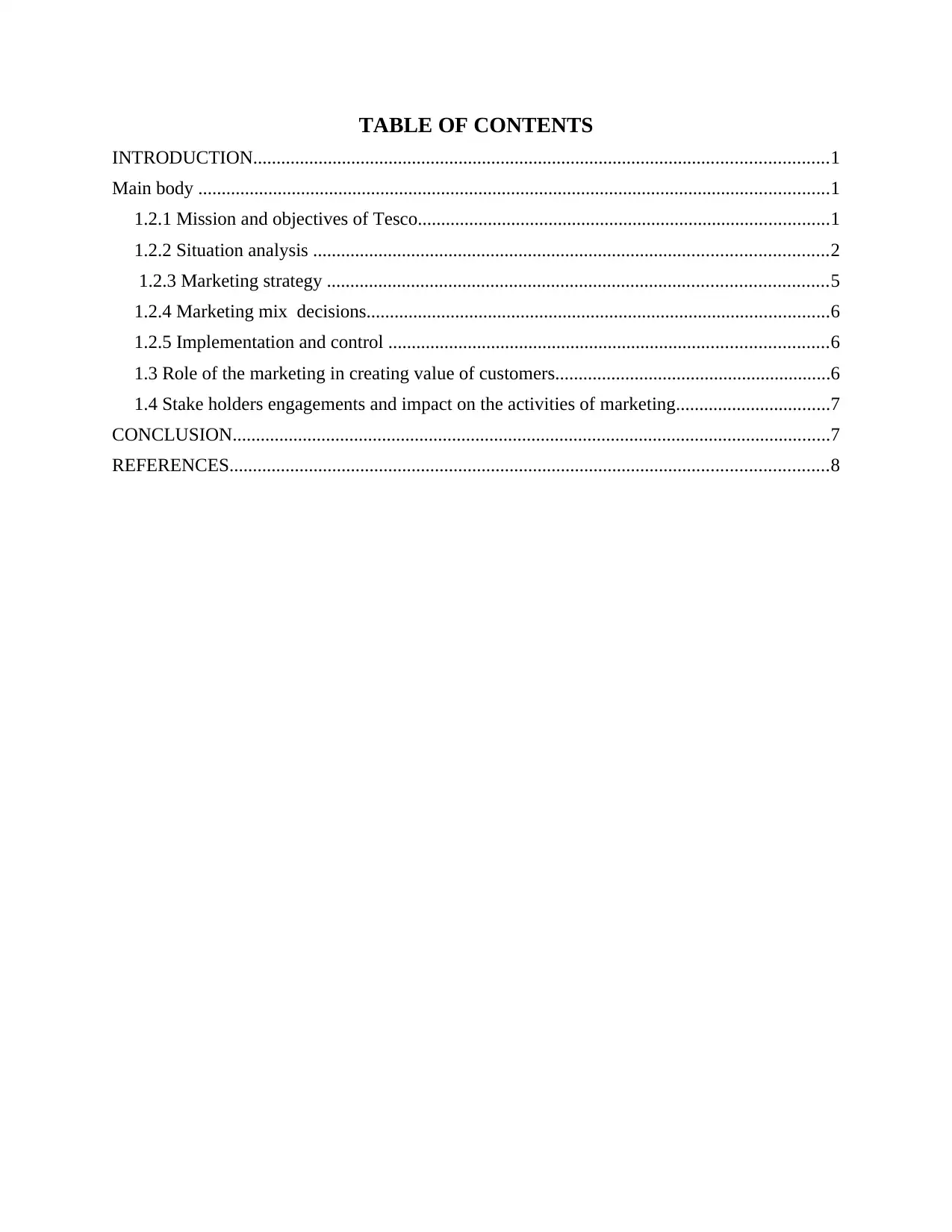
TABLE OF CONTENTS
INTRODUCTION...........................................................................................................................1
Main body .......................................................................................................................................1
1.2.1 Mission and objectives of Tesco........................................................................................1
1.2.2 Situation analysis ..............................................................................................................2
1.2.3 Marketing strategy ...........................................................................................................5
1.2.4 Marketing mix decisions...................................................................................................6
1.2.5 Implementation and control ..............................................................................................6
1.3 Role of the marketing in creating value of customers...........................................................6
1.4 Stake holders engagements and impact on the activities of marketing.................................7
CONCLUSION................................................................................................................................7
REFERENCES................................................................................................................................8
INTRODUCTION...........................................................................................................................1
Main body .......................................................................................................................................1
1.2.1 Mission and objectives of Tesco........................................................................................1
1.2.2 Situation analysis ..............................................................................................................2
1.2.3 Marketing strategy ...........................................................................................................5
1.2.4 Marketing mix decisions...................................................................................................6
1.2.5 Implementation and control ..............................................................................................6
1.3 Role of the marketing in creating value of customers...........................................................6
1.4 Stake holders engagements and impact on the activities of marketing.................................7
CONCLUSION................................................................................................................................7
REFERENCES................................................................................................................................8
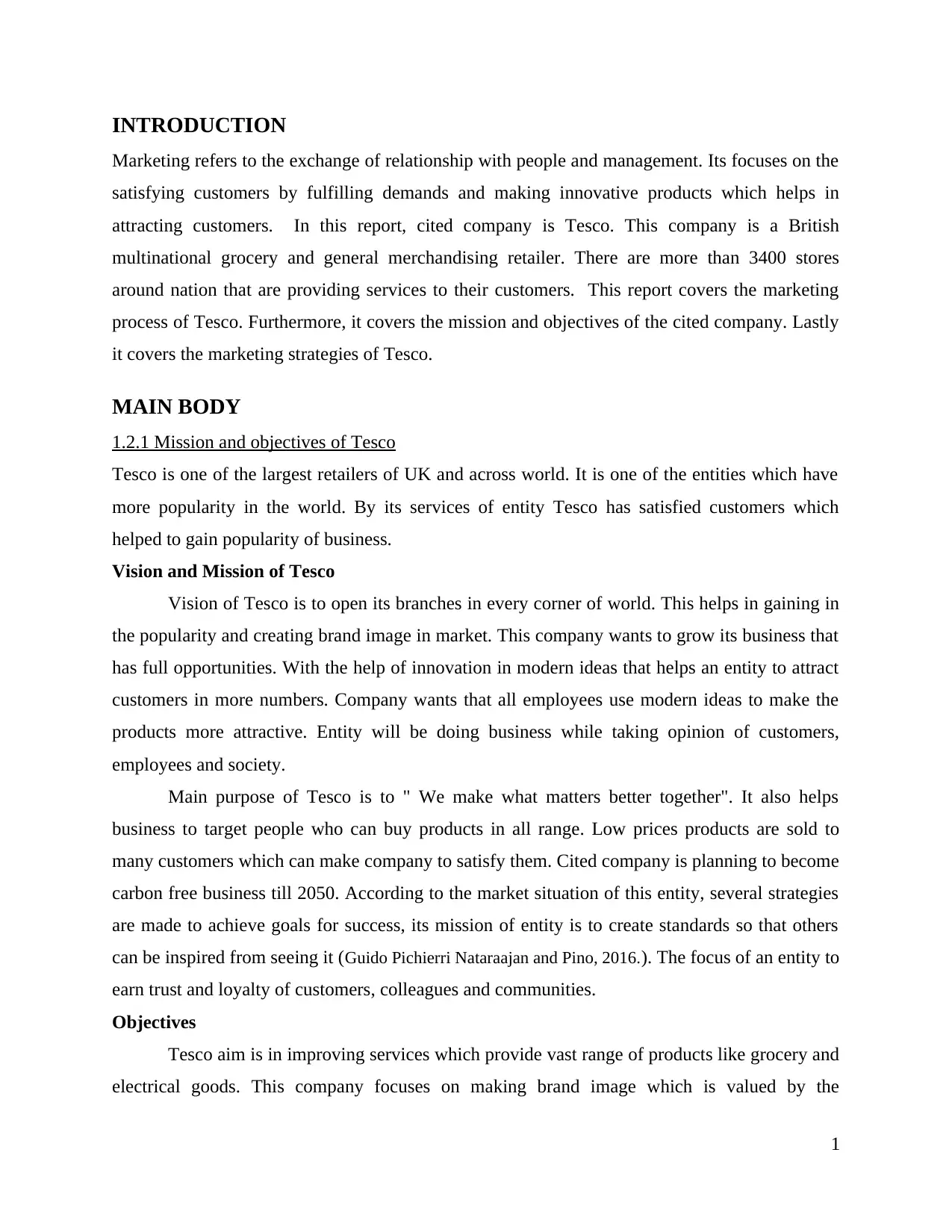
INTRODUCTION
Marketing refers to the exchange of relationship with people and management. Its focuses on the
satisfying customers by fulfilling demands and making innovative products which helps in
attracting customers. In this report, cited company is Tesco. This company is a British
multinational grocery and general merchandising retailer. There are more than 3400 stores
around nation that are providing services to their customers. This report covers the marketing
process of Tesco. Furthermore, it covers the mission and objectives of the cited company. Lastly
it covers the marketing strategies of Tesco.
MAIN BODY
1.2.1 Mission and objectives of Tesco
Tesco is one of the largest retailers of UK and across world. It is one of the entities which have
more popularity in the world. By its services of entity Tesco has satisfied customers which
helped to gain popularity of business.
Vision and Mission of Tesco
Vision of Tesco is to open its branches in every corner of world. This helps in gaining in
the popularity and creating brand image in market. This company wants to grow its business that
has full opportunities. With the help of innovation in modern ideas that helps an entity to attract
customers in more numbers. Company wants that all employees use modern ideas to make the
products more attractive. Entity will be doing business while taking opinion of customers,
employees and society.
Main purpose of Tesco is to " We make what matters better together". It also helps
business to target people who can buy products in all range. Low prices products are sold to
many customers which can make company to satisfy them. Cited company is planning to become
carbon free business till 2050. According to the market situation of this entity, several strategies
are made to achieve goals for success, its mission of entity is to create standards so that others
can be inspired from seeing it (Guido Pichierri Nataraajan and Pino, 2016.). The focus of an entity to
earn trust and loyalty of customers, colleagues and communities.
Objectives
Tesco aim is in improving services which provide vast range of products like grocery and
electrical goods. This company focuses on making brand image which is valued by the
1
Marketing refers to the exchange of relationship with people and management. Its focuses on the
satisfying customers by fulfilling demands and making innovative products which helps in
attracting customers. In this report, cited company is Tesco. This company is a British
multinational grocery and general merchandising retailer. There are more than 3400 stores
around nation that are providing services to their customers. This report covers the marketing
process of Tesco. Furthermore, it covers the mission and objectives of the cited company. Lastly
it covers the marketing strategies of Tesco.
MAIN BODY
1.2.1 Mission and objectives of Tesco
Tesco is one of the largest retailers of UK and across world. It is one of the entities which have
more popularity in the world. By its services of entity Tesco has satisfied customers which
helped to gain popularity of business.
Vision and Mission of Tesco
Vision of Tesco is to open its branches in every corner of world. This helps in gaining in
the popularity and creating brand image in market. This company wants to grow its business that
has full opportunities. With the help of innovation in modern ideas that helps an entity to attract
customers in more numbers. Company wants that all employees use modern ideas to make the
products more attractive. Entity will be doing business while taking opinion of customers,
employees and society.
Main purpose of Tesco is to " We make what matters better together". It also helps
business to target people who can buy products in all range. Low prices products are sold to
many customers which can make company to satisfy them. Cited company is planning to become
carbon free business till 2050. According to the market situation of this entity, several strategies
are made to achieve goals for success, its mission of entity is to create standards so that others
can be inspired from seeing it (Guido Pichierri Nataraajan and Pino, 2016.). The focus of an entity to
earn trust and loyalty of customers, colleagues and communities.
Objectives
Tesco aim is in improving services which provide vast range of products like grocery and
electrical goods. This company focuses on making brand image which is valued by the
1
⊘ This is a preview!⊘
Do you want full access?
Subscribe today to unlock all pages.

Trusted by 1+ million students worldwide
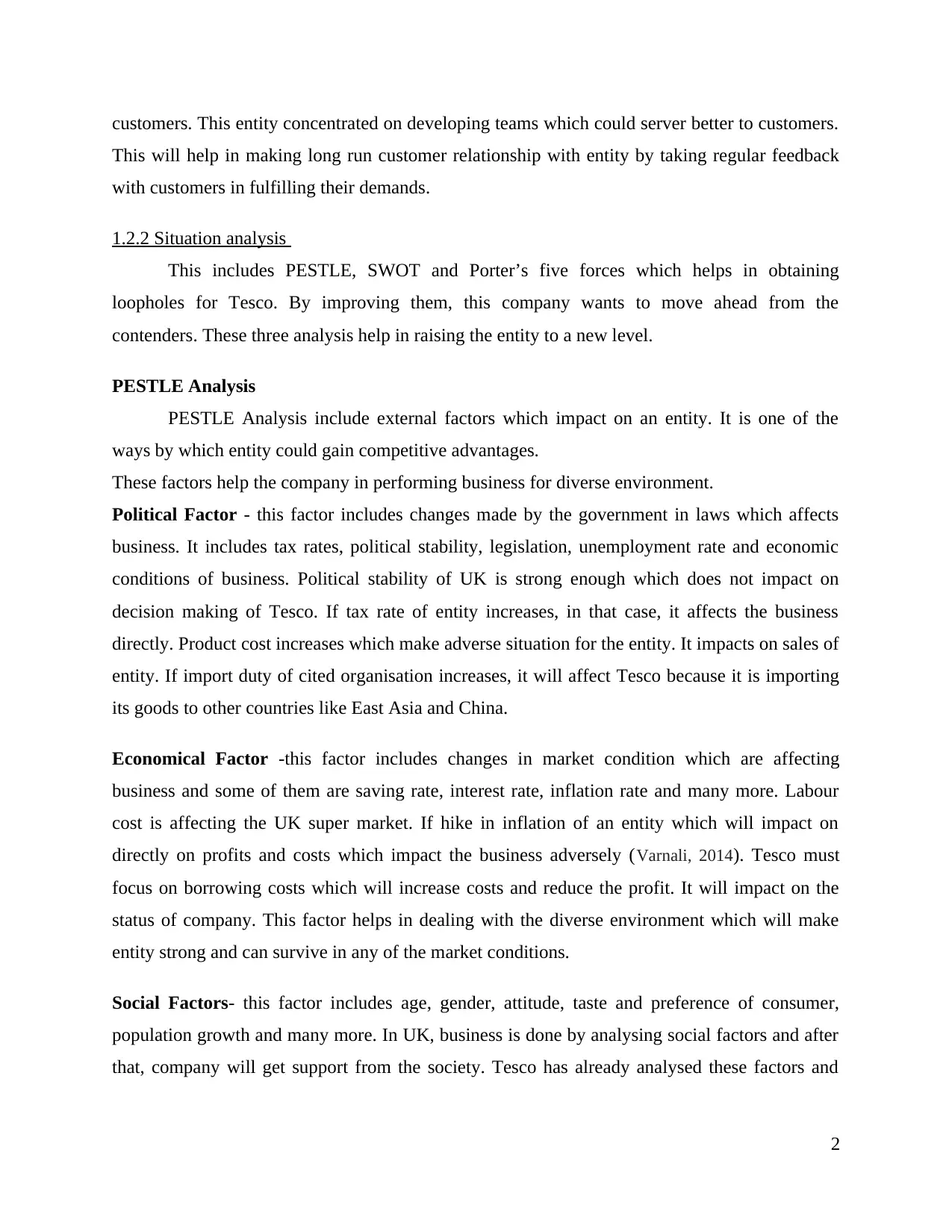
customers. This entity concentrated on developing teams which could server better to customers.
This will help in making long run customer relationship with entity by taking regular feedback
with customers in fulfilling their demands.
1.2.2 Situation analysis
This includes PESTLE, SWOT and Porter’s five forces which helps in obtaining
loopholes for Tesco. By improving them, this company wants to move ahead from the
contenders. These three analysis help in raising the entity to a new level.
PESTLE Analysis
PESTLE Analysis include external factors which impact on an entity. It is one of the
ways by which entity could gain competitive advantages.
These factors help the company in performing business for diverse environment.
Political Factor - this factor includes changes made by the government in laws which affects
business. It includes tax rates, political stability, legislation, unemployment rate and economic
conditions of business. Political stability of UK is strong enough which does not impact on
decision making of Tesco. If tax rate of entity increases, in that case, it affects the business
directly. Product cost increases which make adverse situation for the entity. It impacts on sales of
entity. If import duty of cited organisation increases, it will affect Tesco because it is importing
its goods to other countries like East Asia and China.
Economical Factor -this factor includes changes in market condition which are affecting
business and some of them are saving rate, interest rate, inflation rate and many more. Labour
cost is affecting the UK super market. If hike in inflation of an entity which will impact on
directly on profits and costs which impact the business adversely (Varnali, 2014). Tesco must
focus on borrowing costs which will increase costs and reduce the profit. It will impact on the
status of company. This factor helps in dealing with the diverse environment which will make
entity strong and can survive in any of the market conditions.
Social Factors- this factor includes age, gender, attitude, taste and preference of consumer,
population growth and many more. In UK, business is done by analysing social factors and after
that, company will get support from the society. Tesco has already analysed these factors and
2
This will help in making long run customer relationship with entity by taking regular feedback
with customers in fulfilling their demands.
1.2.2 Situation analysis
This includes PESTLE, SWOT and Porter’s five forces which helps in obtaining
loopholes for Tesco. By improving them, this company wants to move ahead from the
contenders. These three analysis help in raising the entity to a new level.
PESTLE Analysis
PESTLE Analysis include external factors which impact on an entity. It is one of the
ways by which entity could gain competitive advantages.
These factors help the company in performing business for diverse environment.
Political Factor - this factor includes changes made by the government in laws which affects
business. It includes tax rates, political stability, legislation, unemployment rate and economic
conditions of business. Political stability of UK is strong enough which does not impact on
decision making of Tesco. If tax rate of entity increases, in that case, it affects the business
directly. Product cost increases which make adverse situation for the entity. It impacts on sales of
entity. If import duty of cited organisation increases, it will affect Tesco because it is importing
its goods to other countries like East Asia and China.
Economical Factor -this factor includes changes in market condition which are affecting
business and some of them are saving rate, interest rate, inflation rate and many more. Labour
cost is affecting the UK super market. If hike in inflation of an entity which will impact on
directly on profits and costs which impact the business adversely (Varnali, 2014). Tesco must
focus on borrowing costs which will increase costs and reduce the profit. It will impact on the
status of company. This factor helps in dealing with the diverse environment which will make
entity strong and can survive in any of the market conditions.
Social Factors- this factor includes age, gender, attitude, taste and preference of consumer,
population growth and many more. In UK, business is done by analysing social factors and after
that, company will get support from the society. Tesco has already analysed these factors and
2
Paraphrase This Document
Need a fresh take? Get an instant paraphrase of this document with our AI Paraphraser
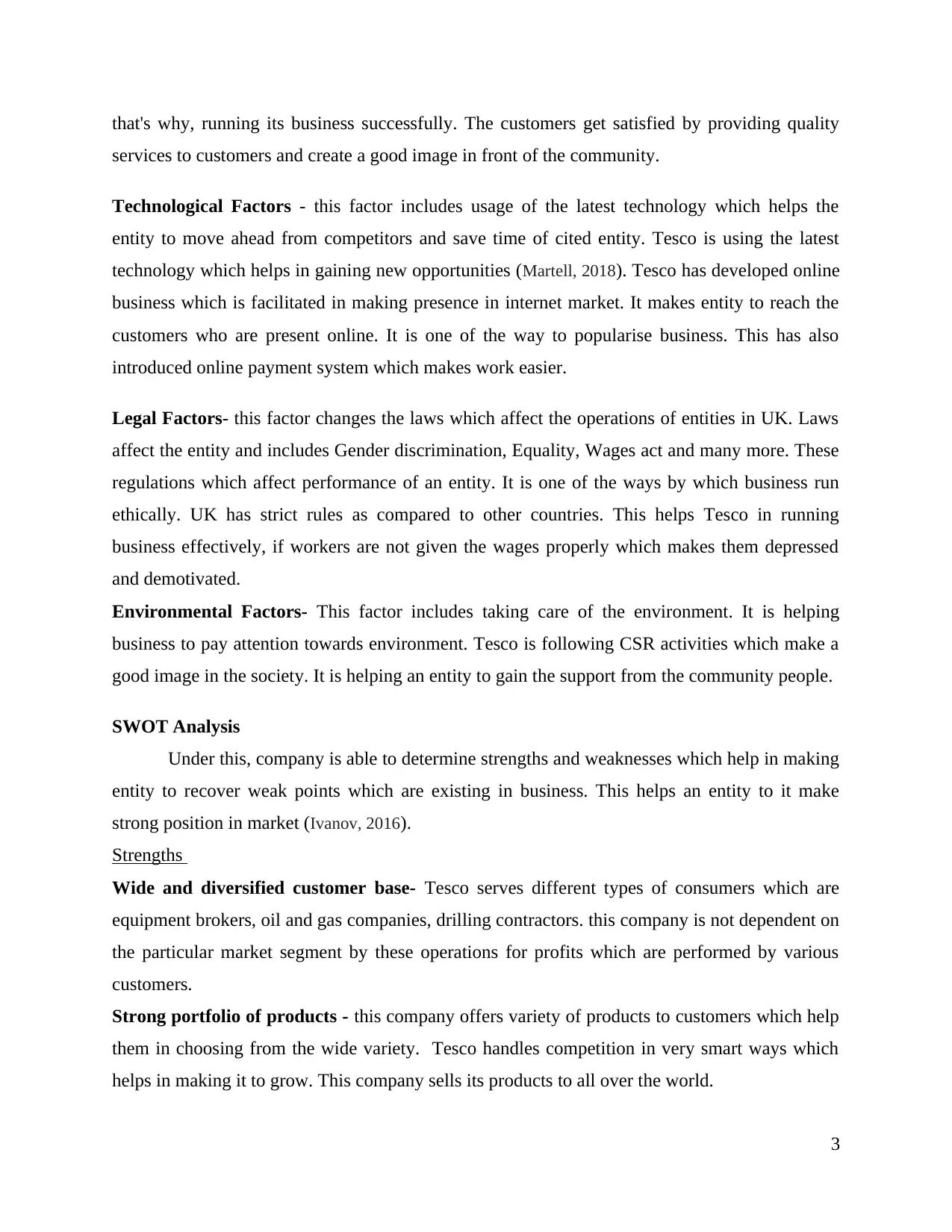
that's why, running its business successfully. The customers get satisfied by providing quality
services to customers and create a good image in front of the community.
Technological Factors - this factor includes usage of the latest technology which helps the
entity to move ahead from competitors and save time of cited entity. Tesco is using the latest
technology which helps in gaining new opportunities (Martell, 2018). Tesco has developed online
business which is facilitated in making presence in internet market. It makes entity to reach the
customers who are present online. It is one of the way to popularise business. This has also
introduced online payment system which makes work easier.
Legal Factors- this factor changes the laws which affect the operations of entities in UK. Laws
affect the entity and includes Gender discrimination, Equality, Wages act and many more. These
regulations which affect performance of an entity. It is one of the ways by which business run
ethically. UK has strict rules as compared to other countries. This helps Tesco in running
business effectively, if workers are not given the wages properly which makes them depressed
and demotivated.
Environmental Factors- This factor includes taking care of the environment. It is helping
business to pay attention towards environment. Tesco is following CSR activities which make a
good image in the society. It is helping an entity to gain the support from the community people.
SWOT Analysis
Under this, company is able to determine strengths and weaknesses which help in making
entity to recover weak points which are existing in business. This helps an entity to it make
strong position in market (Ivanov, 2016).
Strengths
Wide and diversified customer base- Tesco serves different types of consumers which are
equipment brokers, oil and gas companies, drilling contractors. this company is not dependent on
the particular market segment by these operations for profits which are performed by various
customers.
Strong portfolio of products - this company offers variety of products to customers which help
them in choosing from the wide variety. Tesco handles competition in very smart ways which
helps in making it to grow. This company sells its products to all over the world.
3
services to customers and create a good image in front of the community.
Technological Factors - this factor includes usage of the latest technology which helps the
entity to move ahead from competitors and save time of cited entity. Tesco is using the latest
technology which helps in gaining new opportunities (Martell, 2018). Tesco has developed online
business which is facilitated in making presence in internet market. It makes entity to reach the
customers who are present online. It is one of the way to popularise business. This has also
introduced online payment system which makes work easier.
Legal Factors- this factor changes the laws which affect the operations of entities in UK. Laws
affect the entity and includes Gender discrimination, Equality, Wages act and many more. These
regulations which affect performance of an entity. It is one of the ways by which business run
ethically. UK has strict rules as compared to other countries. This helps Tesco in running
business effectively, if workers are not given the wages properly which makes them depressed
and demotivated.
Environmental Factors- This factor includes taking care of the environment. It is helping
business to pay attention towards environment. Tesco is following CSR activities which make a
good image in the society. It is helping an entity to gain the support from the community people.
SWOT Analysis
Under this, company is able to determine strengths and weaknesses which help in making
entity to recover weak points which are existing in business. This helps an entity to it make
strong position in market (Ivanov, 2016).
Strengths
Wide and diversified customer base- Tesco serves different types of consumers which are
equipment brokers, oil and gas companies, drilling contractors. this company is not dependent on
the particular market segment by these operations for profits which are performed by various
customers.
Strong portfolio of products - this company offers variety of products to customers which help
them in choosing from the wide variety. Tesco handles competition in very smart ways which
helps in making it to grow. This company sells its products to all over the world.
3
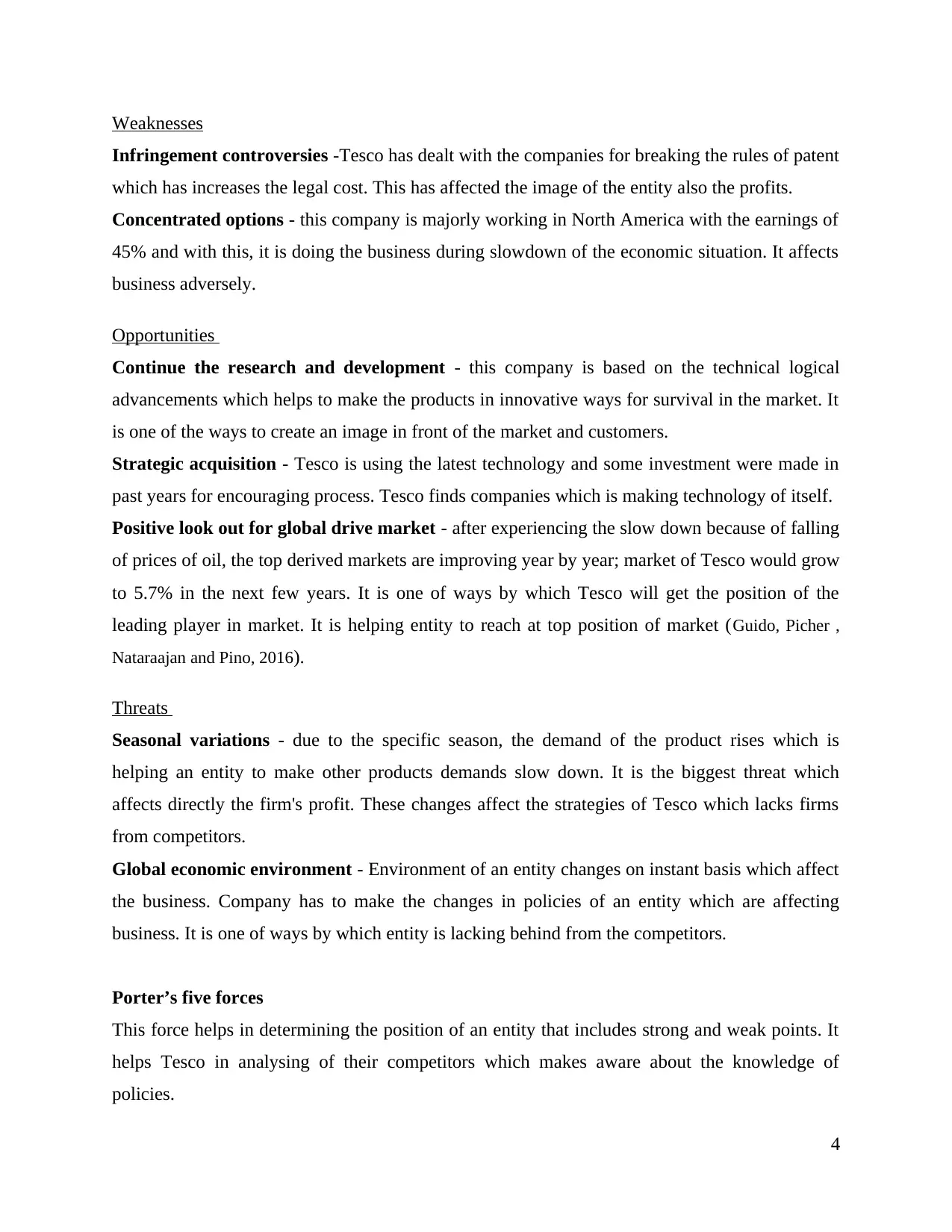
Weaknesses
Infringement controversies -Tesco has dealt with the companies for breaking the rules of patent
which has increases the legal cost. This has affected the image of the entity also the profits.
Concentrated options - this company is majorly working in North America with the earnings of
45% and with this, it is doing the business during slowdown of the economic situation. It affects
business adversely.
Opportunities
Continue the research and development - this company is based on the technical logical
advancements which helps to make the products in innovative ways for survival in the market. It
is one of the ways to create an image in front of the market and customers.
Strategic acquisition - Tesco is using the latest technology and some investment were made in
past years for encouraging process. Tesco finds companies which is making technology of itself.
Positive look out for global drive market - after experiencing the slow down because of falling
of prices of oil, the top derived markets are improving year by year; market of Tesco would grow
to 5.7% in the next few years. It is one of ways by which Tesco will get the position of the
leading player in market. It is helping entity to reach at top position of market (Guido, Picher ,
Nataraajan and Pino, 2016).
Threats
Seasonal variations - due to the specific season, the demand of the product rises which is
helping an entity to make other products demands slow down. It is the biggest threat which
affects directly the firm's profit. These changes affect the strategies of Tesco which lacks firms
from competitors.
Global economic environment - Environment of an entity changes on instant basis which affect
the business. Company has to make the changes in policies of an entity which are affecting
business. It is one of ways by which entity is lacking behind from the competitors.
Porter’s five forces
This force helps in determining the position of an entity that includes strong and weak points. It
helps Tesco in analysing of their competitors which makes aware about the knowledge of
policies.
4
Infringement controversies -Tesco has dealt with the companies for breaking the rules of patent
which has increases the legal cost. This has affected the image of the entity also the profits.
Concentrated options - this company is majorly working in North America with the earnings of
45% and with this, it is doing the business during slowdown of the economic situation. It affects
business adversely.
Opportunities
Continue the research and development - this company is based on the technical logical
advancements which helps to make the products in innovative ways for survival in the market. It
is one of the ways to create an image in front of the market and customers.
Strategic acquisition - Tesco is using the latest technology and some investment were made in
past years for encouraging process. Tesco finds companies which is making technology of itself.
Positive look out for global drive market - after experiencing the slow down because of falling
of prices of oil, the top derived markets are improving year by year; market of Tesco would grow
to 5.7% in the next few years. It is one of ways by which Tesco will get the position of the
leading player in market. It is helping entity to reach at top position of market (Guido, Picher ,
Nataraajan and Pino, 2016).
Threats
Seasonal variations - due to the specific season, the demand of the product rises which is
helping an entity to make other products demands slow down. It is the biggest threat which
affects directly the firm's profit. These changes affect the strategies of Tesco which lacks firms
from competitors.
Global economic environment - Environment of an entity changes on instant basis which affect
the business. Company has to make the changes in policies of an entity which are affecting
business. It is one of ways by which entity is lacking behind from the competitors.
Porter’s five forces
This force helps in determining the position of an entity that includes strong and weak points. It
helps Tesco in analysing of their competitors which makes aware about the knowledge of
policies.
4
⊘ This is a preview!⊘
Do you want full access?
Subscribe today to unlock all pages.

Trusted by 1+ million students worldwide
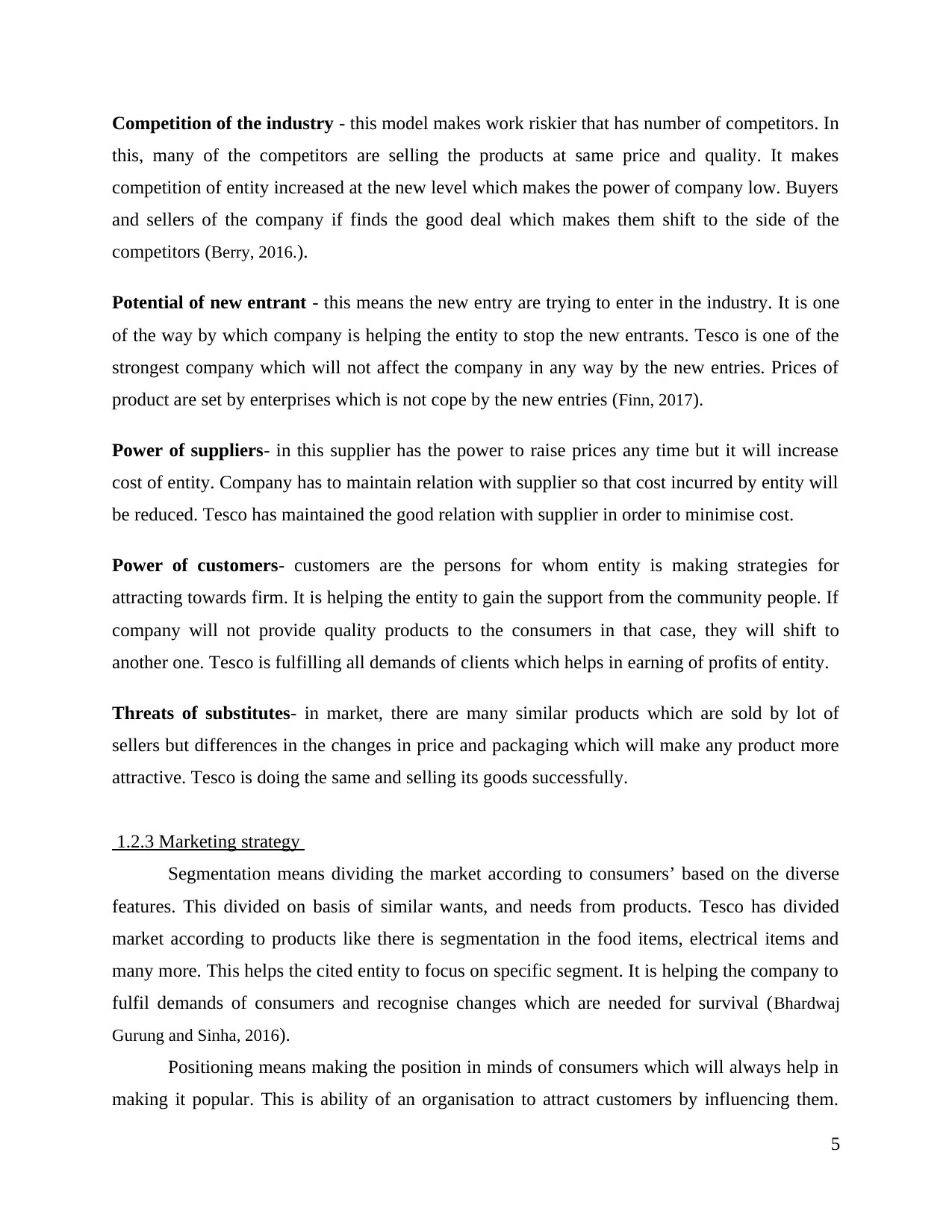
Competition of the industry - this model makes work riskier that has number of competitors. In
this, many of the competitors are selling the products at same price and quality. It makes
competition of entity increased at the new level which makes the power of company low. Buyers
and sellers of the company if finds the good deal which makes them shift to the side of the
competitors (Berry, 2016.).
Potential of new entrant - this means the new entry are trying to enter in the industry. It is one
of the way by which company is helping the entity to stop the new entrants. Tesco is one of the
strongest company which will not affect the company in any way by the new entries. Prices of
product are set by enterprises which is not cope by the new entries (Finn, 2017).
Power of suppliers- in this supplier has the power to raise prices any time but it will increase
cost of entity. Company has to maintain relation with supplier so that cost incurred by entity will
be reduced. Tesco has maintained the good relation with supplier in order to minimise cost.
Power of customers- customers are the persons for whom entity is making strategies for
attracting towards firm. It is helping the entity to gain the support from the community people. If
company will not provide quality products to the consumers in that case, they will shift to
another one. Tesco is fulfilling all demands of clients which helps in earning of profits of entity.
Threats of substitutes- in market, there are many similar products which are sold by lot of
sellers but differences in the changes in price and packaging which will make any product more
attractive. Tesco is doing the same and selling its goods successfully.
1.2.3 Marketing strategy
Segmentation means dividing the market according to consumers’ based on the diverse
features. This divided on basis of similar wants, and needs from products. Tesco has divided
market according to products like there is segmentation in the food items, electrical items and
many more. This helps the cited entity to focus on specific segment. It is helping the company to
fulfil demands of consumers and recognise changes which are needed for survival (Bhardwaj
Gurung and Sinha, 2016).
Positioning means making the position in minds of consumers which will always help in
making it popular. This is ability of an organisation to attract customers by influencing them.
5
this, many of the competitors are selling the products at same price and quality. It makes
competition of entity increased at the new level which makes the power of company low. Buyers
and sellers of the company if finds the good deal which makes them shift to the side of the
competitors (Berry, 2016.).
Potential of new entrant - this means the new entry are trying to enter in the industry. It is one
of the way by which company is helping the entity to stop the new entrants. Tesco is one of the
strongest company which will not affect the company in any way by the new entries. Prices of
product are set by enterprises which is not cope by the new entries (Finn, 2017).
Power of suppliers- in this supplier has the power to raise prices any time but it will increase
cost of entity. Company has to maintain relation with supplier so that cost incurred by entity will
be reduced. Tesco has maintained the good relation with supplier in order to minimise cost.
Power of customers- customers are the persons for whom entity is making strategies for
attracting towards firm. It is helping the entity to gain the support from the community people. If
company will not provide quality products to the consumers in that case, they will shift to
another one. Tesco is fulfilling all demands of clients which helps in earning of profits of entity.
Threats of substitutes- in market, there are many similar products which are sold by lot of
sellers but differences in the changes in price and packaging which will make any product more
attractive. Tesco is doing the same and selling its goods successfully.
1.2.3 Marketing strategy
Segmentation means dividing the market according to consumers’ based on the diverse
features. This divided on basis of similar wants, and needs from products. Tesco has divided
market according to products like there is segmentation in the food items, electrical items and
many more. This helps the cited entity to focus on specific segment. It is helping the company to
fulfil demands of consumers and recognise changes which are needed for survival (Bhardwaj
Gurung and Sinha, 2016).
Positioning means making the position in minds of consumers which will always help in
making it popular. This is ability of an organisation to attract customers by influencing them.
5
Paraphrase This Document
Need a fresh take? Get an instant paraphrase of this document with our AI Paraphraser
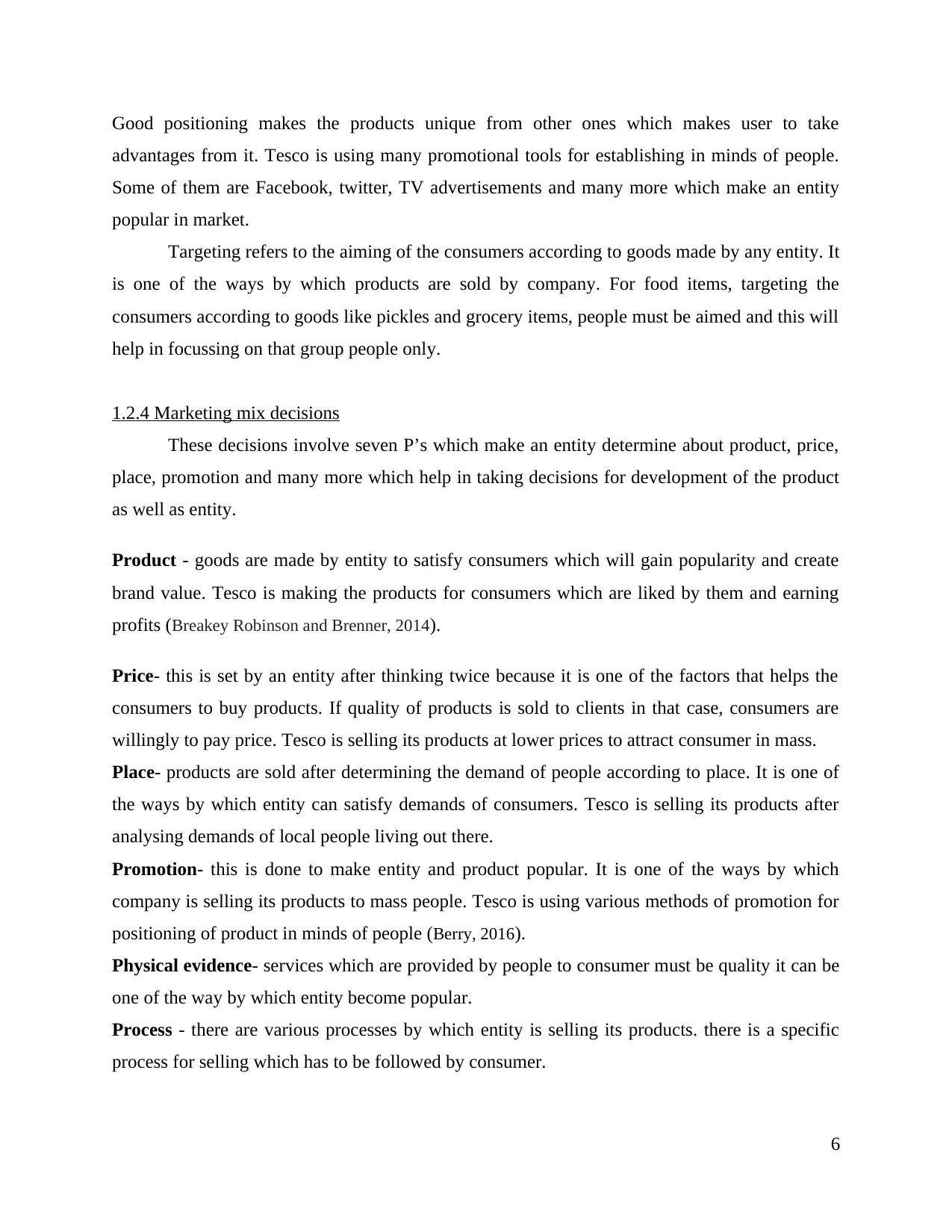
Good positioning makes the products unique from other ones which makes user to take
advantages from it. Tesco is using many promotional tools for establishing in minds of people.
Some of them are Facebook, twitter, TV advertisements and many more which make an entity
popular in market.
Targeting refers to the aiming of the consumers according to goods made by any entity. It
is one of the ways by which products are sold by company. For food items, targeting the
consumers according to goods like pickles and grocery items, people must be aimed and this will
help in focussing on that group people only.
1.2.4 Marketing mix decisions
These decisions involve seven P’s which make an entity determine about product, price,
place, promotion and many more which help in taking decisions for development of the product
as well as entity.
Product - goods are made by entity to satisfy consumers which will gain popularity and create
brand value. Tesco is making the products for consumers which are liked by them and earning
profits (Breakey Robinson and Brenner, 2014).
Price- this is set by an entity after thinking twice because it is one of the factors that helps the
consumers to buy products. If quality of products is sold to clients in that case, consumers are
willingly to pay price. Tesco is selling its products at lower prices to attract consumer in mass.
Place- products are sold after determining the demand of people according to place. It is one of
the ways by which entity can satisfy demands of consumers. Tesco is selling its products after
analysing demands of local people living out there.
Promotion- this is done to make entity and product popular. It is one of the ways by which
company is selling its products to mass people. Tesco is using various methods of promotion for
positioning of product in minds of people (Berry, 2016).
Physical evidence- services which are provided by people to consumer must be quality it can be
one of the way by which entity become popular.
Process - there are various processes by which entity is selling its products. there is a specific
process for selling which has to be followed by consumer.
6
advantages from it. Tesco is using many promotional tools for establishing in minds of people.
Some of them are Facebook, twitter, TV advertisements and many more which make an entity
popular in market.
Targeting refers to the aiming of the consumers according to goods made by any entity. It
is one of the ways by which products are sold by company. For food items, targeting the
consumers according to goods like pickles and grocery items, people must be aimed and this will
help in focussing on that group people only.
1.2.4 Marketing mix decisions
These decisions involve seven P’s which make an entity determine about product, price,
place, promotion and many more which help in taking decisions for development of the product
as well as entity.
Product - goods are made by entity to satisfy consumers which will gain popularity and create
brand value. Tesco is making the products for consumers which are liked by them and earning
profits (Breakey Robinson and Brenner, 2014).
Price- this is set by an entity after thinking twice because it is one of the factors that helps the
consumers to buy products. If quality of products is sold to clients in that case, consumers are
willingly to pay price. Tesco is selling its products at lower prices to attract consumer in mass.
Place- products are sold after determining the demand of people according to place. It is one of
the ways by which entity can satisfy demands of consumers. Tesco is selling its products after
analysing demands of local people living out there.
Promotion- this is done to make entity and product popular. It is one of the ways by which
company is selling its products to mass people. Tesco is using various methods of promotion for
positioning of product in minds of people (Berry, 2016).
Physical evidence- services which are provided by people to consumer must be quality it can be
one of the way by which entity become popular.
Process - there are various processes by which entity is selling its products. there is a specific
process for selling which has to be followed by consumer.
6
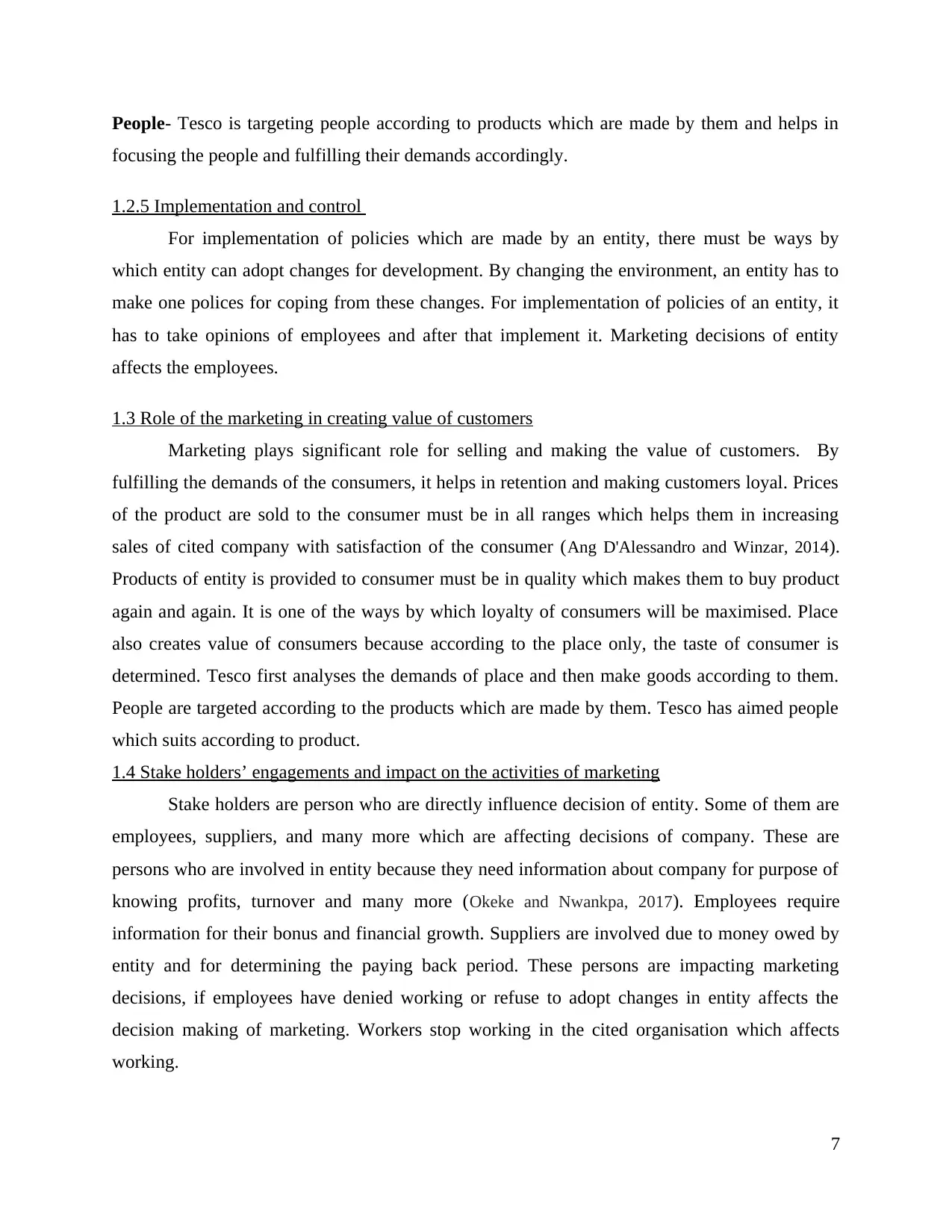
People- Tesco is targeting people according to products which are made by them and helps in
focusing the people and fulfilling their demands accordingly.
1.2.5 Implementation and control
For implementation of policies which are made by an entity, there must be ways by
which entity can adopt changes for development. By changing the environment, an entity has to
make one polices for coping from these changes. For implementation of policies of an entity, it
has to take opinions of employees and after that implement it. Marketing decisions of entity
affects the employees.
1.3 Role of the marketing in creating value of customers
Marketing plays significant role for selling and making the value of customers. By
fulfilling the demands of the consumers, it helps in retention and making customers loyal. Prices
of the product are sold to the consumer must be in all ranges which helps them in increasing
sales of cited company with satisfaction of the consumer (Ang D'Alessandro and Winzar, 2014).
Products of entity is provided to consumer must be in quality which makes them to buy product
again and again. It is one of the ways by which loyalty of consumers will be maximised. Place
also creates value of consumers because according to the place only, the taste of consumer is
determined. Tesco first analyses the demands of place and then make goods according to them.
People are targeted according to the products which are made by them. Tesco has aimed people
which suits according to product.
1.4 Stake holders’ engagements and impact on the activities of marketing
Stake holders are person who are directly influence decision of entity. Some of them are
employees, suppliers, and many more which are affecting decisions of company. These are
persons who are involved in entity because they need information about company for purpose of
knowing profits, turnover and many more (Okeke and Nwankpa, 2017). Employees require
information for their bonus and financial growth. Suppliers are involved due to money owed by
entity and for determining the paying back period. These persons are impacting marketing
decisions, if employees have denied working or refuse to adopt changes in entity affects the
decision making of marketing. Workers stop working in the cited organisation which affects
working.
7
focusing the people and fulfilling their demands accordingly.
1.2.5 Implementation and control
For implementation of policies which are made by an entity, there must be ways by
which entity can adopt changes for development. By changing the environment, an entity has to
make one polices for coping from these changes. For implementation of policies of an entity, it
has to take opinions of employees and after that implement it. Marketing decisions of entity
affects the employees.
1.3 Role of the marketing in creating value of customers
Marketing plays significant role for selling and making the value of customers. By
fulfilling the demands of the consumers, it helps in retention and making customers loyal. Prices
of the product are sold to the consumer must be in all ranges which helps them in increasing
sales of cited company with satisfaction of the consumer (Ang D'Alessandro and Winzar, 2014).
Products of entity is provided to consumer must be in quality which makes them to buy product
again and again. It is one of the ways by which loyalty of consumers will be maximised. Place
also creates value of consumers because according to the place only, the taste of consumer is
determined. Tesco first analyses the demands of place and then make goods according to them.
People are targeted according to the products which are made by them. Tesco has aimed people
which suits according to product.
1.4 Stake holders’ engagements and impact on the activities of marketing
Stake holders are person who are directly influence decision of entity. Some of them are
employees, suppliers, and many more which are affecting decisions of company. These are
persons who are involved in entity because they need information about company for purpose of
knowing profits, turnover and many more (Okeke and Nwankpa, 2017). Employees require
information for their bonus and financial growth. Suppliers are involved due to money owed by
entity and for determining the paying back period. These persons are impacting marketing
decisions, if employees have denied working or refuse to adopt changes in entity affects the
decision making of marketing. Workers stop working in the cited organisation which affects
working.
7
⊘ This is a preview!⊘
Do you want full access?
Subscribe today to unlock all pages.

Trusted by 1+ million students worldwide
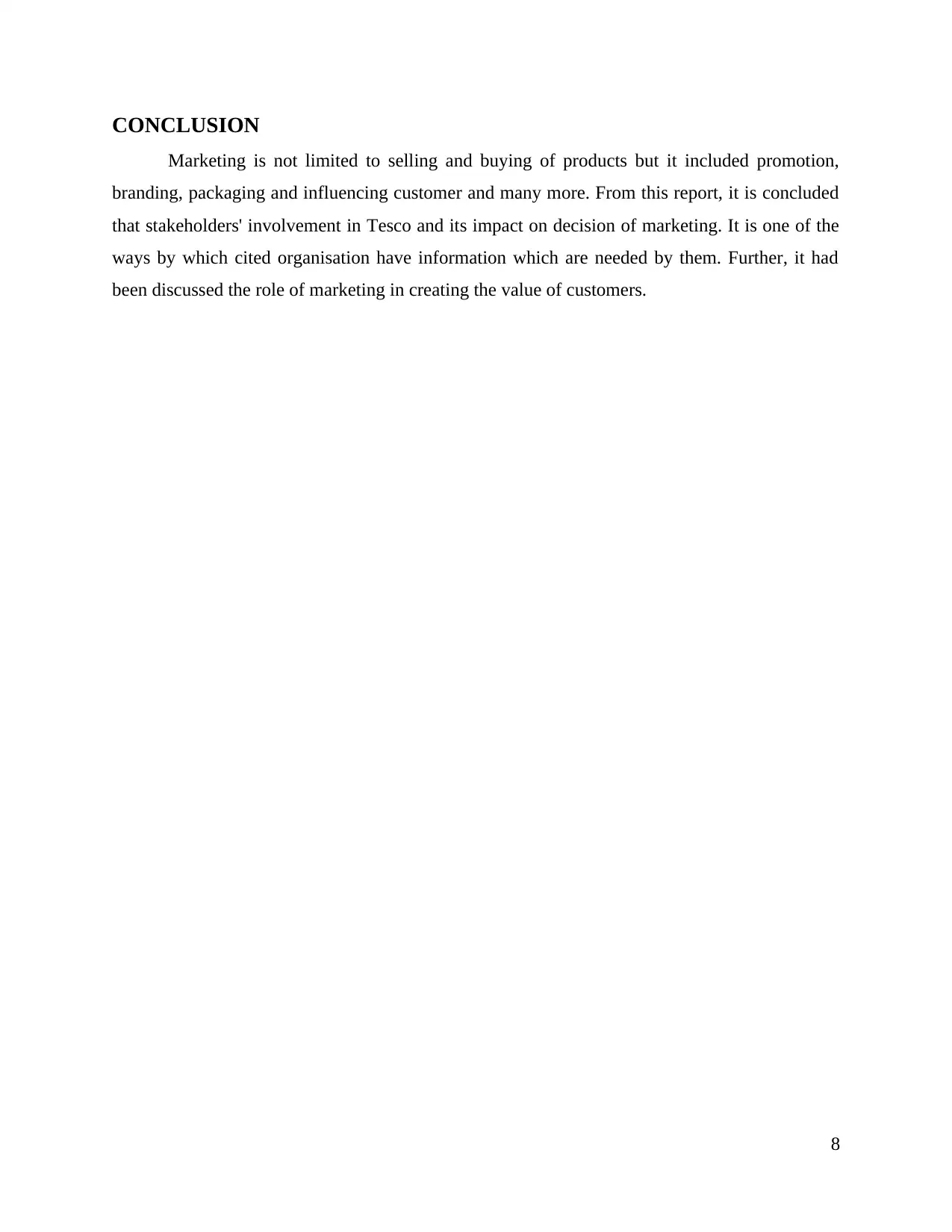
CONCLUSION
Marketing is not limited to selling and buying of products but it included promotion,
branding, packaging and influencing customer and many more. From this report, it is concluded
that stakeholders' involvement in Tesco and its impact on decision of marketing. It is one of the
ways by which cited organisation have information which are needed by them. Further, it had
been discussed the role of marketing in creating the value of customers.
8
Marketing is not limited to selling and buying of products but it included promotion,
branding, packaging and influencing customer and many more. From this report, it is concluded
that stakeholders' involvement in Tesco and its impact on decision of marketing. It is one of the
ways by which cited organisation have information which are needed by them. Further, it had
been discussed the role of marketing in creating the value of customers.
8
Paraphrase This Document
Need a fresh take? Get an instant paraphrase of this document with our AI Paraphraser
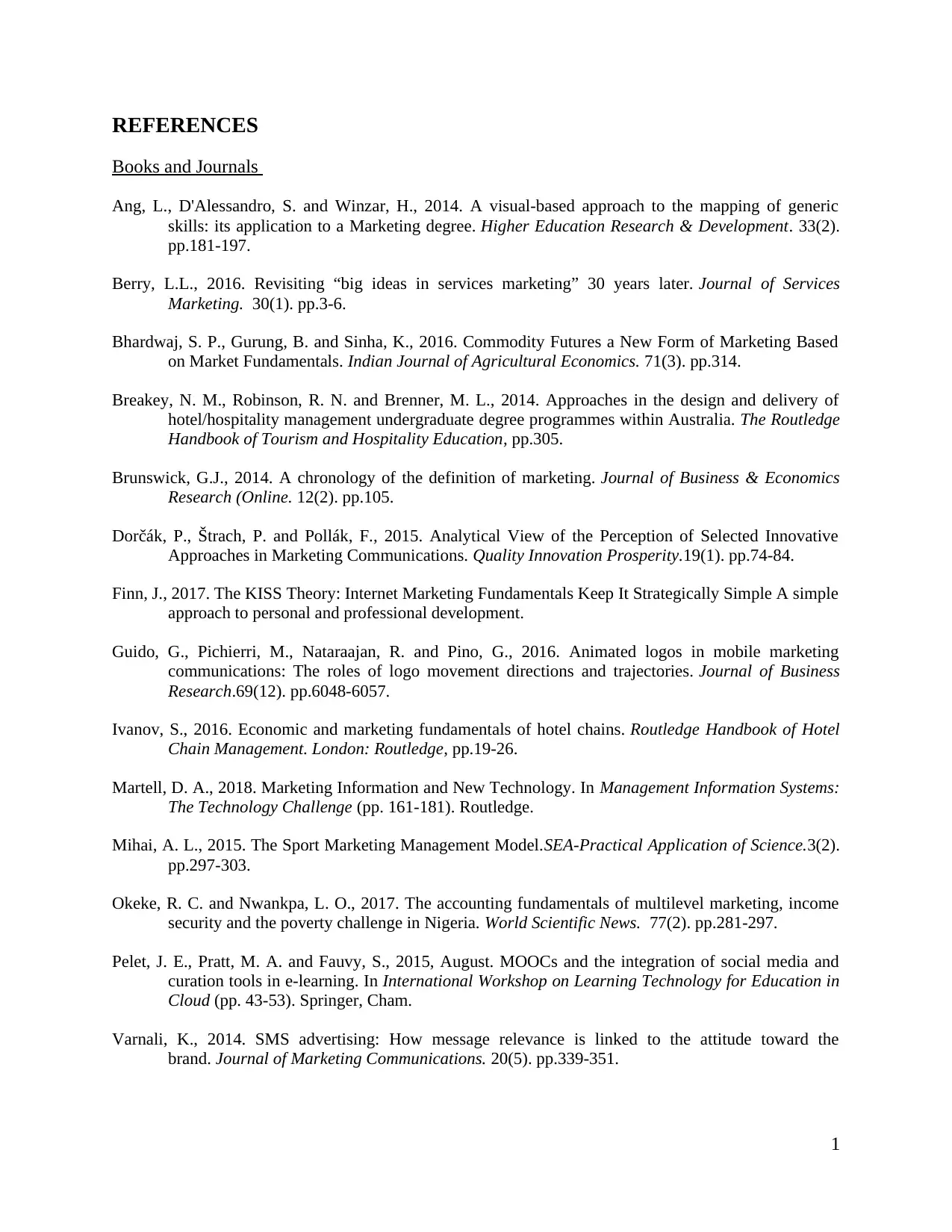
REFERENCES
Books and Journals
Ang, L., D'Alessandro, S. and Winzar, H., 2014. A visual-based approach to the mapping of generic
skills: its application to a Marketing degree. Higher Education Research & Development. 33(2).
pp.181-197.
Berry, L.L., 2016. Revisiting “big ideas in services marketing” 30 years later. Journal of Services
Marketing. 30(1). pp.3-6.
Bhardwaj, S. P., Gurung, B. and Sinha, K., 2016. Commodity Futures a New Form of Marketing Based
on Market Fundamentals. Indian Journal of Agricultural Economics. 71(3). pp.314.
Breakey, N. M., Robinson, R. N. and Brenner, M. L., 2014. Approaches in the design and delivery of
hotel/hospitality management undergraduate degree programmes within Australia. The Routledge
Handbook of Tourism and Hospitality Education, pp.305.
Brunswick, G.J., 2014. A chronology of the definition of marketing. Journal of Business & Economics
Research (Online. 12(2). pp.105.
Dorčák, P., Štrach, P. and Pollák, F., 2015. Analytical View of the Perception of Selected Innovative
Approaches in Marketing Communications. Quality Innovation Prosperity.19(1). pp.74-84.
Finn, J., 2017. The KISS Theory: Internet Marketing Fundamentals Keep It Strategically Simple A simple
approach to personal and professional development.
Guido, G., Pichierri, M., Nataraajan, R. and Pino, G., 2016. Animated logos in mobile marketing
communications: The roles of logo movement directions and trajectories. Journal of Business
Research.69(12). pp.6048-6057.
Ivanov, S., 2016. Economic and marketing fundamentals of hotel chains. Routledge Handbook of Hotel
Chain Management. London: Routledge, pp.19-26.
Martell, D. A., 2018. Marketing Information and New Technology. In Management Information Systems:
The Technology Challenge (pp. 161-181). Routledge.
Mihai, A. L., 2015. The Sport Marketing Management Model.SEA-Practical Application of Science.3(2).
pp.297-303.
Okeke, R. C. and Nwankpa, L. O., 2017. The accounting fundamentals of multilevel marketing, income
security and the poverty challenge in Nigeria. World Scientific News. 77(2). pp.281-297.
Pelet, J. E., Pratt, M. A. and Fauvy, S., 2015, August. MOOCs and the integration of social media and
curation tools in e-learning. In International Workshop on Learning Technology for Education in
Cloud (pp. 43-53). Springer, Cham.
Varnali, K., 2014. SMS advertising: How message relevance is linked to the attitude toward the
brand. Journal of Marketing Communications. 20(5). pp.339-351.
1
Books and Journals
Ang, L., D'Alessandro, S. and Winzar, H., 2014. A visual-based approach to the mapping of generic
skills: its application to a Marketing degree. Higher Education Research & Development. 33(2).
pp.181-197.
Berry, L.L., 2016. Revisiting “big ideas in services marketing” 30 years later. Journal of Services
Marketing. 30(1). pp.3-6.
Bhardwaj, S. P., Gurung, B. and Sinha, K., 2016. Commodity Futures a New Form of Marketing Based
on Market Fundamentals. Indian Journal of Agricultural Economics. 71(3). pp.314.
Breakey, N. M., Robinson, R. N. and Brenner, M. L., 2014. Approaches in the design and delivery of
hotel/hospitality management undergraduate degree programmes within Australia. The Routledge
Handbook of Tourism and Hospitality Education, pp.305.
Brunswick, G.J., 2014. A chronology of the definition of marketing. Journal of Business & Economics
Research (Online. 12(2). pp.105.
Dorčák, P., Štrach, P. and Pollák, F., 2015. Analytical View of the Perception of Selected Innovative
Approaches in Marketing Communications. Quality Innovation Prosperity.19(1). pp.74-84.
Finn, J., 2017. The KISS Theory: Internet Marketing Fundamentals Keep It Strategically Simple A simple
approach to personal and professional development.
Guido, G., Pichierri, M., Nataraajan, R. and Pino, G., 2016. Animated logos in mobile marketing
communications: The roles of logo movement directions and trajectories. Journal of Business
Research.69(12). pp.6048-6057.
Ivanov, S., 2016. Economic and marketing fundamentals of hotel chains. Routledge Handbook of Hotel
Chain Management. London: Routledge, pp.19-26.
Martell, D. A., 2018. Marketing Information and New Technology. In Management Information Systems:
The Technology Challenge (pp. 161-181). Routledge.
Mihai, A. L., 2015. The Sport Marketing Management Model.SEA-Practical Application of Science.3(2).
pp.297-303.
Okeke, R. C. and Nwankpa, L. O., 2017. The accounting fundamentals of multilevel marketing, income
security and the poverty challenge in Nigeria. World Scientific News. 77(2). pp.281-297.
Pelet, J. E., Pratt, M. A. and Fauvy, S., 2015, August. MOOCs and the integration of social media and
curation tools in e-learning. In International Workshop on Learning Technology for Education in
Cloud (pp. 43-53). Springer, Cham.
Varnali, K., 2014. SMS advertising: How message relevance is linked to the attitude toward the
brand. Journal of Marketing Communications. 20(5). pp.339-351.
1
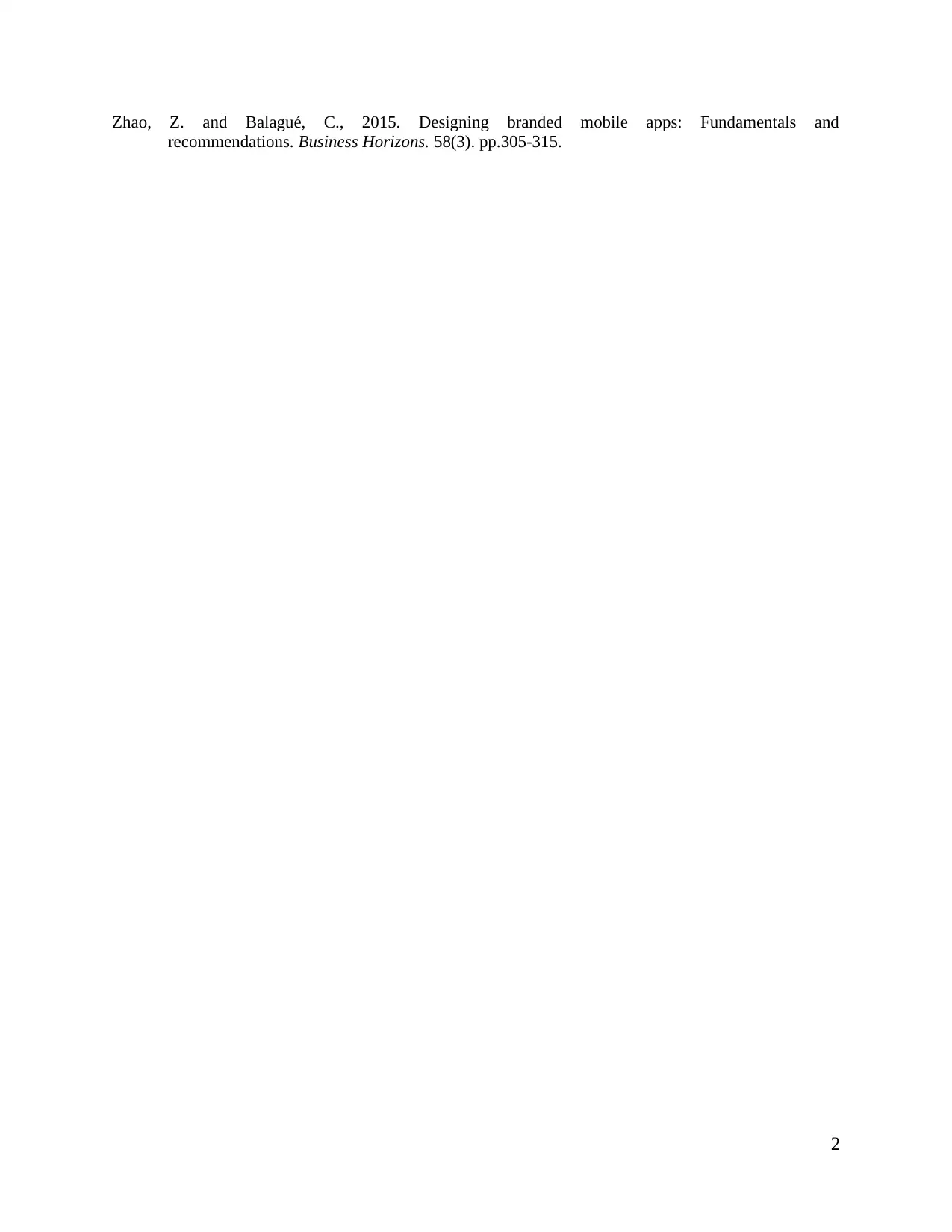
Zhao, Z. and Balagué, C., 2015. Designing branded mobile apps: Fundamentals and
recommendations. Business Horizons. 58(3). pp.305-315.
2
recommendations. Business Horizons. 58(3). pp.305-315.
2
⊘ This is a preview!⊘
Do you want full access?
Subscribe today to unlock all pages.

Trusted by 1+ million students worldwide
1 out of 12
Related Documents
Your All-in-One AI-Powered Toolkit for Academic Success.
+13062052269
info@desklib.com
Available 24*7 on WhatsApp / Email
![[object Object]](/_next/static/media/star-bottom.7253800d.svg)
Unlock your academic potential
Copyright © 2020–2025 A2Z Services. All Rights Reserved. Developed and managed by ZUCOL.





